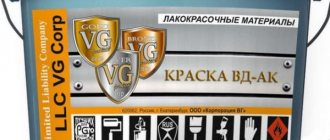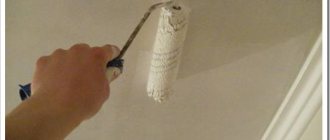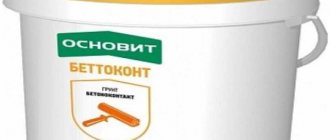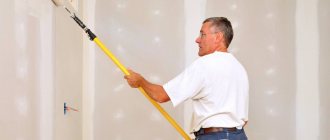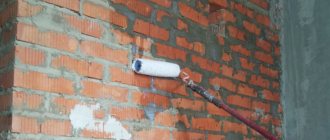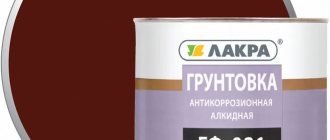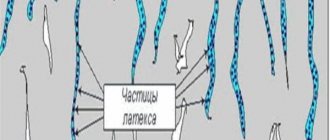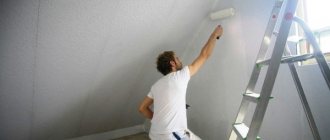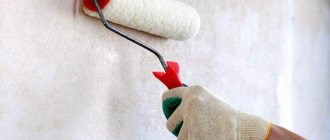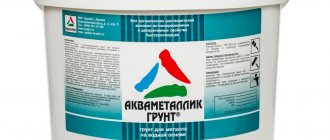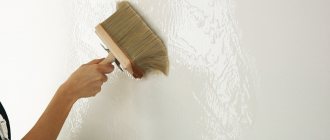Functions of deep penetration primer
When planning repair work, you need to clearly understand why each technological operation is being performed. Application of a deep penetration primer allows you to:
- strengthen the surface of bulk and porous materials;
- improve the adhesion of the base of the wall and ceiling with finishing materials;
- reduce the absorbency of building materials. This makes it possible:
- reduce the consumption of wallpaper or tile adhesive, paint;
- ensure uniform application, which means a higher quality finish;
- get a smoother surface.
- prevent the development of pathogenic microflora;
- bind the dust.
Deep primer
A soil that can penetrate deep into the base of the treated surface has a specific composition, technical characteristics, pros and cons, and scope of application.
Peculiarities
The inclusion of finely dispersed latex (particles 30-60 nanometers in size) in the solution allows the primer to penetrate deeply into the composition of the material being processed due to the capillary effect. Therefore, such primers have good strengthening and leveling abilities while simultaneously preventing the absorption of moisture by the base from plaster mortars, adhesives and paints.
But the adhesive properties are relatively low, which must be taken into account when processing dense materials: metal, plastic, glass. You cannot use such soil directly and under heavy cladding: large-format ceramic slabs, porcelain stoneware, thick layer of cement plaster (more than 3 cm).
Compound
All types of deep penetration primers have three basic components: a binder, a solvent, and polymers. Depending on the purpose, various additives are added to the listed substances. Therefore, in a multicomponent composition you can find:
- acrylic resins - responsible for the viscosity and adhesion of the soil to the base and finishing materials;
- water - diluent;
- latex particles - penetrate into the base to a depth of 15 mm. After hardening, the loose and friable surface is strengthened by binding the particles of the top layer;
- silicone - forms a moisture-proof film;
- antifoaming agents - prevent the formation of foam during dilution and application;
- driers - accelerators of the drying process;
- modifiers - responsible for the level of vapor permeability of a wall or ceiling;
- antiseptics (fungicides) - prevent the growth of pathogenic microorganisms (fungus, mold);
- dyes - allow you to see the quality of surface treatment.
Specifications
Due to the different composition of primers, their technical and operational characteristics may be different, but they comply with the requirements of GOST R 52020-2003 “Water-dispersion paint and varnish materials”, which must be confirmed by a certificate of conformity.
Here are the averages:
- mass fraction of non-volatile (non-evaporating) components - 12-20%, with a minimum value of 5%;
- specific gravity - 1.0-1.1 kg/l;
- penetration depth - 5-10 mm;
- primer particle size - 0.05-0.15 microns;
- acidity - 7.0-8.5 pH (refers to neutral solutions);
- drying time - 1-3 hours, maximum value - 12 hours;
- requirements for air temperature during application - +5-+35oС. Some manufacturers are tightening them up. For example, it indicates the minimum value of the indicator +12oС. Others lower the upper threshold to 28oC;
- operating temperature - from -40oC to +60oC;
- average consumption per 1 m2 is 100-200 ml. On the packaging of some manufacturers you can see 75 and even 50 ml/m2, which is not confirmed in practice. This must be taken into account when calculating the required amount of soil;
- shelf life remains for 18-36 months.
Principle of operation
The action of deep penetration soil is based on the ability of polymers (latex) to penetrate deep into the treated material (gas blocks, concrete, brick, drywall, wood, etc.) due to the capillary effect.
After the solvent evaporates, the latex and resins form long, strong threads, making a strong frame for the top layer of the primed surface, in which all the small and scattered particles of the base are “glued together.” Modifiers provide vapor permeability, silicone creates a waterproof film, and the binding components of the composition improve the adhesion of the base to finishing materials.
The working principle of deep penetration primer.
Best Penetrating Primers
It is better to choose a reputable brand of penetrating primer. When purchasing cheap, little-known analogues, there is a high risk of getting a product that was manufactured in violation of technological standards. But such compositions can, on the contrary, destroy the base, even one made of concrete.
Prospectors
Soil can penetrate into the smallest cracks and pores. It contains quartz sand, which increases the adhesive properties of the treated surface with finishing. The mixture is used outside the building, inside it, in rooms with normal and high humidity.
Surfaces coated with “Starateli” primer can be plastered, puttyed, painted, covered with tiles and wallpaper. The mixture is suitable for floors; after applying it, floor coverings can be laid.
The composition cannot be used on surfaces with low adhesive ability. This primer is prohibited for surfaces that come into contact with food and drinking water.
Consumption per 1 m2 is on average 100-200 ml/m2. After application, the primer will dry for at least 1 hour.
“Prospectors” is a latex primer, with a latex share in the dry residue of 30%. The shelf life of the composition in original packaging is no more than 12 months. from the date of production at temperatures from 5 to 30°C.
Ceresit
Water-dispersion primer, the active components are synthetic resins. All components ensure good soil absorption and prevent its premature drying. The average consumption per 1 m2 of wall is from 100 to 200 ml/m2, and the penetration depth into the primed material is up to 10 cm. Drying time of the composition is 4-6 hours at an air temperature of 5..30-35°C. Wood and gypsum boards treated with Ceresit primer dry for at least a day.
Optimist
Deep penetration primer Optimist is used for interior and exterior work.
This is a fine latex soil to which modified additives, mineral sand and fungicides are added. You can prime surfaces exposed to moisture. The soil levels the walls and increases their adhesive properties. The drying time of the layer is 2 hours. Consumption per 1 m2 is 50 g.
Bolars
Bolars primer is white in color and has a transparent composition. They can be used to strengthen cellular concrete, gypsum plaster, cement-sand or cement-lime screed. Applying Bolars primer helps reduce the consumption of materials for finishing.
Tex
Tex primer is a universal primer, the depth of penetration of which into porous materials is up to 0.6 cm. Good absorption makes the primer an excellent material for preparing facades and walls inside buildings for finishing. It can be used in rooms with high dampness and before wallpapering or tiling.
Knauf
Knauf is one of the leading manufacturers of building compounds. Implemented since the early 90s.
- “Betokontakt” from Knauf is a deep-penetrating polymer-based primer with an admixture of mineral sand.
- Tiefengrund Knauf is a quick-drying primer that can be used before puttying, before painting and laying tiles.
The primer consumption rate is from 0.08 to 0.25 l/m2. The depth of penetration into the treated material is 5-6 cm. Drying time of the composition is 2-3 hours.
LNPP
The composition forms a protective crust of one tone. It can be used as a primer to prepare the surface before painting with acrylic and water-based paints. Concrete, brick and plastered walls, plasterboard, fiberboard and asbestos cement can be treated with primer.
Lakra
This is a deep penetration polyurethane primer with the addition of a disinfecting component. It strengthens the base, fills all minor flaws and surface defects, and increases its adhesive properties.
Thanks to the antiseptics included in the composition, the soil protects walls from the development of rot and mold, so it can be used in bathrooms and toilets.
Glims
Glims primer is sold ready-made and does not require dilution. This is a waterproof primer based on polymers made in Germany. Creates a uniform layer, helps strengthen porous materials and increase their adhesion. Plastered and glossy walls cannot be treated.
Axton
This is latex primer. Reliably strengthens loose and fine-grained surfaces. Penetrates deeply into concrete, brick, plaster and plasterboard substrates. Can be used to cover facades and interior walls, and can be used for all types of finishing work.
Polastra
Copolymer primer based on acrylic with the addition of sand and additives. Use indoors with normal and increased dampness. It can be used to treat walls and ceilings before plastering or laying tiles.
Mixonit GR 43
You can use the soil on surfaces that will be covered with tiles or facing stones. The composition penetrates the wall to a depth of 10 cm. It does not have a sharp toxic odor. After priming, the surface continues to allow steam and air to pass through. The soil contains antiseptic and fire retardant additives.
Proacrylic primer
Binding elements are latex and acrylate. Additional components of the primer are antiseptics and a defoamer. Due to the foam absorber, the composition does not foam during stirring.
Can be applied to mineral bases and wood. Suitable for interior and exterior work. Latex makes the treated surface moisture resistant.
Scope of application
Deep penetration primer does not have a very wide range of applications. This is due to its specific properties: to hold together loose and porous surfaces, and therefore the adhesion force is insufficient to hold heavy types of finishes.
Floor
A self-leveling floor on a cement screed, firstly, does not spread well, and secondly, it loses strength due to disruption of the hydration process: the cement draws water out of the solution. Deep penetration primer eliminates these shortcomings. Primed twice. The first can be a diluted primer in a 1:1 ratio.
Walls
Walls can be made of different materials. Therefore, you need to take into account the characteristics of each material:
- concrete (reinforced concrete) is primed before painting or wallpapering;
- foam concrete and gas blocks are treated with a deep penetration primer before plastering or puttying with gypsum solutions. When applying cement plaster, first apply deep penetration soil, then “Betonokontakt”;
- plasterboard for putty and paint is primed with a deep penetration primer; for laying tiles and porcelain stoneware, a primer is first applied, then “Betonokontakt”;
- the brick is processed before applying gypsum solutions;
- old cement-sand plaster must be impregnated at least twice to strengthen the surface;
- new cement plaster is primed before wallpapering and applying gypsum solutions;
Important: deep penetration primer when finishing cement on cement is not the best option. There are more effective types of primers.
- the wood is treated with shellac impregnations.
The outside walls are primed with paint and decorative plaster.
Ceiling
Regardless of the type of base (concrete floor or gypsum board), the ceiling is primed under wallpaper and paint.
Prospectors
has existed on the Russian market for more than 20 years, producing dry building mixtures, solutions, and paint and varnish products. A penetrating primer based on acrylic, with the addition of antiseptics and an antifoam agent, is produced by the manufacturer in plastic containers of 5 and 10 liters.
The solution is intended for interior and exterior work on surfaces that are not subject to deformation:
- drywall;
- tree;
- concrete;
- brick and other surfaces.
Not for use on steel or oil-based surfaces.
The penetration depth of the emulsion is up to 5 mm, it is moisture- and wear-resistant, odorless and environmentally friendly. Storage is possible at positive temperatures not exceeding 30 degrees; freezing is allowed for no more than 5 cycles.
Prospectors
Technical characteristics of the primer Prospectors:
- flow rate from 100 to 200 ml/m2;
- drying time 1 hour;
- air temperature during application from 5 to 30°C heat;
- when applied to a porous structure, dilute 1:1;
- shelf life 12 months.
The solution is applied with a spray gun, brush or roller. Suitable for priming before various types of work: painting, wallpapering, tiling.
For more information about the deep penetration primer Prospectors, watch the video:
Advantages and disadvantages
Deep penetration soil has its strengths and weaknesses.
- affordable price for the mass consumer;
- long service life - at least 30 years;
- good adhesion to the treated surface due to deep penetration of polymers;
- strengthens the top layer of loose and porous materials;
- creates a moisture-proof film, as a result of which water is not drawn out from plaster mortars and adhesives under tiles and wallpaper - the course of chemical reactions is not disturbed;
- paint, varnishes, enamels, wallpaper glue are saved due to lower consumption;
- versatility: can be applied to loose, porous and smooth materials inside and outside the building;
- easy to apply with your own hands;
- maintains vapor permeability of walls and ceilings;
- prevents the formation and growth of cracks;
- withstands a wide range of temperatures during operation - from -40oC to +60oC;
- the solution is frost-resistant - can withstand up to 5 freezing cycles during transportation and storage;
- dries quickly;
- To save money, the soil for the first layer can be diluted with water in a 1:1 ratio.
- colored solutions lose their indicating properties on concrete and cement-sand surfaces;
- there is not always enough adhesion force for a thick layer of plaster when finishing cement on cement;
- Lays down unevenly: there are always streaks on the wall.
Kinds
In information articles on the World Wide Web you can find a huge number of types of deep penetration primers. In fact, there are only 4 types: two for the binder and two more for the area of application.
By binder
The basis for deep application soil can be:
- acrylic is a traditional binder;
- shellac - based on shellac resins, wood impregnation is produced, which, due to additives, can be classified as a primer.
All other types of solution bases: alkyd and epoxy resins, polystyrene, polyvinyl acetate, etc. used for the production of general purpose or universal primers. It is not the same.
By area of application
Depending on the place of application, deep penetration soil can be classified into compositions for indoor and outdoor use.
Attention: deep penetration primer cannot be universal in purpose - it is a different type of primer. If the bottle or canister is labeled “universal,” then this refers to the area of application: for internal and external processing.
Types of primers and their purpose
The description of most types of work states that the base needs to be primed. For this stage, special compounds are used, which are called primers (that is, primers). What is a primer? This is a construction liquid mixture that helps prepare the surface for further finishing. In this case, “next” can be anything, either intermediate or final. Take, for example, wall decoration - from “bare masonry” to painting or wallpapering. First, prime the wall itself, and when the plaster has dried completely, you should apply a primer to it, then putty. The puttied surfaces are primed again, and then painted or wallpapered. This number of primer layers is not necessary, but is an option. The primer is used when finishing the surface of the ceiling, floor, walls and facade, that is, everywhere. There are subspecies for interior and exterior work, some that are used in both.
Types of primers
As can be seen from the example, the base on which the primer composition will be applied may be different. For example, concrete and foam block walls, concrete floors, plasterboard or putty ceilings. They are completely different in characteristics, which means that different preparation is needed, which covers the problems of this or that material. There are specific priming compositions to solve all problems. In general, based on the results of the action, four groups can be distinguished.
- Filling. These are compounds that reduce the hygroscopicity of the base, as well as its absorbency. Should be applied to highly absorbent surfaces. They are needed for smoothing out small irregularities and filling joints in ceramic tiles, plank floors and parquet before filling. They are applied under the paint in order to reduce its consumption and so that it goes on evenly. It is also used under plaster so that the walls do not draw moisture from the plaster composition and it has enough moisture to gain the required level of strength. Filling primers are needed for plastered walls under tile adhesive in order to increase the service life of the adhesive due to the fact that the liquid will be absorbed more slowly, as well as for plaster or putty before gluing wallpaper, so that the surface begins to absorb the adhesive more slowly, etc.
- Adhesive or film-forming. Such compositions are applied to poorly absorbent types of substrates in order to improve adhesion. After drying, a sticky film will remain on the surface, onto which it will be much easier to apply the plaster composition. A film-forming primer will increase the adhesive ability (so the materials will adhere better).
- Deep penetration (penetrating). This type of primer composition is used for those types of bases that cannot be removed from dust. Gypsum plasters, chalk-type paints and other surfaces that leave a trace of dust on your hands. The task of this type of composition is to bind dust particles and ensure normal adhesion to another layer. Of the variety of bases, deep penetration acrylic primers are much more numerous, and they fill approximately 4/5 of the market.
- Strengthening. This is a special type of primer that is used to bind loose substrates. This type of primer also has deep penetration, but contains more adhesive components, due to which the particles will bond not just in a small surface layer, but also to a greater depth. It is usually used for renovation work in old housing or for restoration/restoration of decoration.
There are also universal formulations, and they are the cheapest. The description usually contains a large list of properties, but in fact, universal formulations have the fewest active components. This is also a primer, but much weaker. This type is used only if there is no great need for a primer, for example, under paint or wallpaper.
Problems solved by primers
Primers must provide excellent adhesion between the two layers, and this is their main purpose. Most often, this requires adjusting the absorbency of the bases. The fact is that all finishing materials - putties, plasters, glue, paints - are developed for substrates with an average degree of absorption, and there are not many of them. Usually the absorbency has to be adjusted, and sometimes it is necessary to reduce the absorbency, and sometimes to create a sticky film on a very smooth or poorly absorbent surface. Primers address such problems. There are also compounds that reduce absorbency while simultaneously improving waterproofing and combating high levels of humidity. This is also included in the tasks of the composition, and for this they are also used.
Primers with deep penetration are bound by particles that are on the surface. The compositions penetrate deep into loose materials to a depth of 0.5 to 0.7 cm and bind the particles together. By the way, a “side” effect will be a decrease in hygroscopicity, as well as absorption. Often is not always, so it is worth carefully studying the properties. Even after the primer has dried, an adhesive film may appear on the surface, because the unabsorbed composition dries and leaves sticky marks. This will improve the conditions for applying the next material. It turns out that some types of primer increase surface strength and adhesion. Certain formulations also have antibacterial properties, while others only contain special anti-mold or antifungal additives.
Sometimes a primer is used to “make friends” with gypsum and cement based materials. Without this, there will be no normal clutch. For example, if concrete walls or walls made of cement-based blocks are going to be covered with gypsum plaster, Betonokontakt from the manufacturer Knauf will be a classic and proven solution. It can be applied to almost any type of mineral base under gypsum materials and ensures their high-quality adhesion.
Types of primer bases
So, we have come to the point that when choosing a primer, you should focus on the characteristics of the base. Based on their ability to absorb, they are divided into the following groups:
- Low absorbency or non-absorbent. This group includes concrete surfaces, cement-type plaster, refractory bricks, expanded polystyrene, sand concrete, gypsum tongue-and-groove slabs.
- With average absorption capacity. This is a simple brick and the base is perfect, so it does not need a primer, but only if the brick does not crumble. Wood is a complex substrate and requires a primer.
- With high absorption capacity. These are foam concrete and gas silicate blocks, any cellular pieces of concrete, white silicate brick, lime and gypsum, cement plasters and plaster mixtures.
A deep penetration primer for walls is important, and the absorbency of the surface should also be determined. To do this, you need to apply drops of water to the surface and monitor the time during which it will be absorbed. If it took more than 1/3 of an hour, the surface does not absorb, and if less than 3 minutes have passed, then the surface absorbs strongly. Everything in between has average absorbency. In this case, you are lucky and can do without compounds that regulate water absorption. Now it’s clear how to choose a primer composition. For surfaces with low absorption capacity, film-forming ones are suitable, and for surfaces with high absorption capacity, deep penetration or filling type primers are used. Products with deep penetration are needed if the surface is dusty, but not crumbling or loose.
Recommendations for selection
It is difficult to make a mistake when choosing a deep penetration primer, because... There are only two parameters to consider:
- humidity - buy a solution with antiseptic additives (fungicides) to prevent mold or mildew from growing;
- place of use - frost-resistant compounds are needed for facade treatment.
Some specialists and experts talk about materials on the walls, types of finishes, etc. But you cannot find a deep penetration primer for concrete, brick or drywall on sale.
Purpose of the primer
Primer application has three main purposes:
- Strengthening loose and porous surfaces
. Deep penetration into the structure of the material promotes gluing of individual particles, thereby increasing the strength of the base. After applying the primer, small particles of plaster stop crumbling, the amount of dust on the treated surface is minimized, etc. - Increased adhesion.
Due to the special properties of the primer, plaster gypsum polymer mixtures and putty do not peel off from the base. - Elimination of mold, fungi and other microflora.
Due to their antibacterial properties, deep penetration primers help increase the antiseptic properties of the treated surface.
In addition, the surface treated with primer absorbs moisture less, which allows reducing the consumption of finishing materials by 5 - 10%
Materials and tools
To apply deep penetration primer you will need:
- deep penetration primer for a specific type of base and finish;
- spray gun for mechanized work.
The operation can be performed manually if you have:
- stepladders - required when processing wall-ceiling joints;
- ditches for priming;
- a medium-sized brush for applying mortar in the corners and joints of the wall with the floor and ceiling;
- a wide brush (maklovitsa) or a roller with a handle for treating walls.
Consumption per 1 m2
It is impossible to talk about consumption rates for deep penetration primers per 1 m2. Many factors influence the value of the indicator:
- the amount of non-volatile substance in the solution (composition of components);
- surface type: loose, porous, smooth;
- method of application;
- level of moisture absorption by the treated base.
Therefore, manufacturers indicate the average value of soil consumption per 1 m2. For example, an acrylic deep penetration primer has an approximate consumption of 130-150 ml/m2 for one layer. For loose and porous surfaces, the indicator should be increased by 15-25% for the first layer. If there are a large number of protrusions and corners, the figures given are adjusted upward by 10% for each pass.
When applied with a brush, the rate increases by 5%, with a roller - by 8-10%, with a spray gun - 5-10%. Then everything is simple: the area under the primer is calculated, the resulting figure is multiplied by the consumption of soil for each layer, taking into account correction factors. The results are summed up and divided by the container volume. Rounding is carried out upward or packaging of different volumes is taken.
Rating of the best brands
Before purchasing soil, you should familiarize yourself with the features of products from well-known manufacturers.
"Bolars"
This company offers quality products. It has scientific laboratories that determine the quality of raw materials and finished products. The primer of this brand helps strengthen the structure of porous materials, increases the degree of adhesion and reduces the cost of paints and varnishes during subsequent finishing.
The Bolars primer composition has proven itself in the building materials market. Numerous reviews of this product confirm its cost-effectiveness and quick drying.
"Knauf"
This is a very large manufacturer of construction materials, whose products are widely distributed throughout the world. The company offers its consumers high-quality environmentally friendly materials known throughout the world. The company produces high-quality environmentally friendly materials.
Expert opinion
Zakharova Irina Yurievna
Cleaning professional with 15 years of experience. Our best expert.
Ask a Question
Strengthening deep-penetrating soil "Knauf" is of high quality and affordable price. Other advantages of the material include high adhesion and quick drying.
"Optimist"
This manufacturer offers customers a separate line of deep-penetrating primers. Facade silicone primer is used for outdoor work. It helps to increase the level of moisture resistance and stabilize vapor permeability. The composition also helps strengthen loose and fragile foundations.
Interior primer, which features an acrylic base, can be applied over old oil paint or alkyd enamel. It can be used for floor treatment. The composition contains an antiseptic component that helps prevent the formation of mold and fungi. The primer strengthens the structure of the coating.
See also
Composition and types of paints in plastic cans, how to apply the spray correctly
Penetrating primer concentrate helps to achieve a high degree of adhesion. After its application, a moisture-proof protective film is formed on the surface. Buyers note the ease of application and good absorption of the composition. In addition, the soil is characterized by low consumption and minimal drying time.
This primer mixture has excellent properties and good quality. However, it also has a number of disadvantages. These include an unpleasant odor and an overly liquid texture.
"Prospectors"
The deep-penetrating solution from this manufacturer is suitable for external and internal work. It helps strengthen the base and reduces paint consumption during subsequent finishing. The primer contains antiseptics. They provide protection for the coating from fungi and mold.
The advantages of the primer are a smooth and durable coating, excellent price-quality ratio, and high drying speed. Minor disadvantages include a slight smell.
"Tex"
This brand offers a separate line of deep penetration primers. The “Universal” composition is suitable for application to a porous base before using water-dispersed compounds, puttying, or installing tiles.
Water-dispersion mixture "Economy" is recommended for use for interior finishing work. It is suitable for use in rooms with high humidity parameters. The composition can also be used as a coating for wallpaper. The solution is suitable for interior and exterior decoration. With its help, it is possible to improve adhesion performance and reduce the cost of paints and varnishes.
The advantages of the products include affordable cost, excellent quality, quick drying, and excellent adhesion parameters. The product is easily absorbed and helps strengthen the surface. A slight downside is the strong smell.
"Ceresit"
This brand itself conducts scientific research and develops technologies for the production of finishing materials. Ceresit CT 17 soil is considered the most popular in the building materials market.
The advantages of the product include the possibility of use for any absorbent surfaces, ease of application, short drying period, increased adhesion.
See also
Types of wood primers for varnish and rating of the best brands, application rules
The composition also strengthens the surface structure, binds dust and reduces the absorption of the coating. The substance reduces the consumption of paints and varnishes during subsequent finishing and is considered economical. The disadvantages of the mixture include high cost and pungent odor.
Application instructions
In the instructions for using primers, manufacturers indicate the requirements for the surface to be treated and describe the application technology.
Surface preparation
Considering that the walls inside and outside the building, the ceiling and floor are primed for a specific type of finish, intermediate or final, it makes no sense to consider in detail the technology for preparing the surface for plaster, paint or wallpaper: each type of finish has its own requirements.
Detailed instructions can be found in the works:
- “How to prepare walls for plaster?”;
- “How to prepare walls for wallpapering?”;
- “Leveling walls for painting”;
- “How to prepare a ceiling for painting with water-based paint?”;
- “How to put wallpaper on the ceiling?”;
- “How to fill a self-leveling floor on a balcony?”
Let us briefly recall some points:
- there should be no oil stains on the treated surface - latex does not penetrate through them through capillaries into the materials;
- existing metal parts are either removed or treated with anti-rust;
- highly porous materials and cracks are sealed with special solutions or cement laitance;
- dust and debris are removed.
Primer application technology
This type of work, such as applying primer to the surface, is quite simple and can be done with your own hands. This does not require any equipment.
When working you will need:
Soil is poured into a plastic container so that the roller is submerged by one third. No more, because the liquid will drain from it. With its help, large surfaces of walls are covered with a primer, and the work time is also reduced.
There is no need to apply a very large amount. Acrylic primer has high penetrating ability. It is enough for the solution to simply cover the surface.
Brushes are used in corners and other hard-to-reach places. They can also be used to remove possible leaks.
The surface is primed twice. The second coat of primer is applied only after the first has completely dried.
Priming technology
All surfaces are primed in the same way as they are painted.
Brush
Use a small brush to treat corners and the joints of the wall with the ceiling and floor. Rough and porous surfaces are primed with a paintbrush - the primer gets into the recesses better. For this:
- the primer is poured into the cuvette;
- the brush is dipped 1/3 into the poured solution, after which it is shaken lightly so that it does not flow down the handle;
- start from below with horizontal movements. The hand brush is held in relation to the surface being treated at almost a right angle. The pressure is weak.
After applying the first coat, the primer must dry completely. You can see how long it takes for the primer to dry on the packaging. The second layer is applied with vertical movements from bottom to top. If you apply it the other way around, a lot of the solution will end up on the floor.
Roller
You can prime dense surfaces with a roller from top to bottom strictly vertically, covering the already applied strip by about 5 cm so that there are no missed areas.
Spray gun
Not everyone has a spray gun at home, and renting one is expensive. Therefore, you can use a spray bottle placed on a plastic bottle of sparkling water or drinks.
Application is carried out from top to bottom - this way there are fewer drips. The technology is well suited for all types of surfaces: porous, loose, smooth. The second layer is applied after the first has finished drying.
Details of the technology can be found here.
Betonkontakt
Many people smear concrete contact wherever there is a hint of its use. In fact, this soil only had one useful application. These are places where there is no way to remove old paint. In other places, concrete contact can often be not only useless, but also harmful.
Someone applies it before pouring the screed, not realizing that many variations of this product are not resistant to alkali, and the solution is an alkaline mixture. As a result, the concrete contact layer simply dissolves under the aggressive action of cement.
Some people apply this primer to smooth concrete before plastering. This is somehow justified when plastering with gypsum mixtures. However, in my experience, gypsum plaster holds up well even without concrete contact, provided the base is properly prepared. Concrete contact is relevant when it is not possible to peel off all the paint, when alkyd paint is removed using the hot method - although the paint has been removed from the surface, all the pores are in the paint.
As a result, there was a lot of text, but now you can immediately understand the purpose of the soil in a given situation.
Rate this publication:
- Currently 4.13
Rating: 4.1 (38 votes)
Popular manufacturers
Manufacturer ratings help you choose a good primer. But it is always subjective. Therefore, the editors of the site selected the most frequently encountered brands from several ratings already compiled in 2021.
"Ceresite". One of the most popular primers is “Ceresit” CT17 on an acrylic base. Produced at enterprises under the Ceresit brand. The composition is universal: it can be used both for internal and external surface treatment.
Application of primer allows:
- strengthen the top layer of the walls before finishing work;
- prevent the plaster mortar from falling off;
- reduce the level of moisture absorption of treated structures;
- level the surface for paint.
"Ceresit" CT 17 penetrates to a depth of up to 10 mm. It has a light yellow tint, which allows you to see untreated areas. Dries in 2-4 hours. Consumption - 100-200 ml/m2. The price of a 10-liter canister starts from 670 rubles. in construction markets. From retailers - from 770 rubles.
"Knauf". Under the Knauf brand, almost the entire range of building materials is produced, from dry plaster mixtures to various plasterboard products. Primers occupy a significant place in the product line. One of them, Knauf Tiefengrund penetrating, is well known to professional builders and home craftsmen.
Users like the soil:
- for guaranteed penetration to a sufficiently large depth of the primed base;
- good vapor permeability;
- Possibility of use inside and outside the building.
It is used for treating walls, ceilings and floors made of concrete, gypsum plasterboard, fiberboard, chipboard, brick, gas and foam concrete, etc. Standard technical specifications:
- consumption - 100-200 ml/m2;
- drying time - 1-2 hours.
You can buy 10 liters for 670-980 rubles.
"Prospectors". The deep penetration soil “Starateli” has proven itself positively in all respects in a short period of time. Having practically the same technical and operational indicators as the product of famous brands, it costs less. For 5 liters you need to pay about 300 rubles.
Used for processing brick walls, concrete panels and floors, cement-sand screed and plaster, plasterboard, foam concrete, gypsum polymer plaster. Dries quickly in about 1 hour. Consumption 100-200 ml/m2.
"Optimist". Primer "Optimist" is a product of domestic manufacturers. The quality is practically not inferior to foreign analogues, but it costs much less, which ensures stable demand.
The scope of application is wider, which is caused by higher adhesion - it can withstand ceramic tiles on vertical surfaces. In addition, it can be used on facades under tiles, paint and decorative plaster.
Dries within 1-2 hours. Consumption - 100-250 ml/m2. Costs from 419 to 870 rubles/10 liters.
"Eunice." The “Unis” primer penetrates deeply into the structure of the material, due to which the surface of loose and porous materials is strengthened, microcracks and pores are sealed, the base is leveled for painting, and the adhesion force for subsequent finishing is increased.
You can prime concrete structures, gypsum and cement plasters, lime-whitened walls and ceilings, gypsum boards, aerated concrete for tiles, paint, plaster and wallpaper. Can be used indoors on walls, floors and ceilings, outside on facades.
Average consumption is 100-165 ml/m2. Dries in no more than 1 hour. The price ranges from 370 to 710 rubles/10 liters.
Farbitex. The Farbitex primer has a very high level of adhesion - it can withstand all types of finishing materials.
The primer is intended for the treatment of gypsum plasters and putties, bricks, plasterboard, concrete surfaces indoors and outdoors before finishing. Penetrating deeply, it prevents the formation of cracks. Containing fungicides, it can be used in damp rooms - mold and mildew will not be able to reproduce.
Increased consumption - 150-250 ml/m2. Dries in about 2 hours. The price starts from 300 rub./5 l.
"Tex." Deep penetration primer "Tex" has good technical and operational properties at a low price. So, a 5 liter canister can be bought for 180-230 rubles. The soil is frost-resistant. Therefore, it can be used on facade work under decorative plaster, tiles and paint.
Dries quickly - in 1.5 hours. Consumption 110-200 ml/m2.
What is
Deep penetration primer is a modern material with which you can not only protect the surface of walls, but also prepare them really well for further processing.
Deep penetration primer is a modern material with which you can not only protect the surface of walls, but also prepare them really well for further processing. This type of soil is capable of penetrating quite deeply into a variety of materials and at the same time performing a huge number of different functions at the same time. As numerous practice shows, deep penetration primer makes finishing work several times higher quality and increases its service life.
Purpose of the primer
It is necessary to apply primer to the surface of those walls or ceilings that will be processed in the future for several reasons. The main ones include the following:
- Helps strengthen porous or loose surfaces. Due to the fact that the primer penetrates directly into the structure of the material as deeply as possible, it allows particles of this material to be glued together. Thanks to this, the strength of the base increases several times. After deep penetration soil is applied to the wall, small particles stop crumbling, and less dust is generated during repair work.
- Increases adhesion index. Due to its unique properties, the primer can improve adhesion between the surface and the material used for further finishing.
- Eliminates mold, mildew and various dangerous microorganisms. The primer has antibacterial properties and helps to increase the antiseptic properties of the surface being treated several times.
Experts also note the fact that if you use deep penetration soil, the surface stops absorbing moisture so much.
Due to this, the amount of finishing materials is significantly reduced, on average by 5-10%.
Properties and Application
Primer compositions, which are offered by different manufacturers, may differ from each other not only in composition, properties, but also in the method of application. But at the same time, there are certain characteristics that remain common to the products of each deep penetration soil manufacturer. The main ones include the following points:
- The mass fraction of volatile components can reach 20%. Moreover, the main ingredient of any composition is water.
- The primer composition has exactly the same density as water. Today you can find a small number of manufacturers who offer products with a higher density than water.
- On average, processing one square meter of surface will require from 100 to 200 grams of the composition. This variation is due to the fact that products from different manufacturers do not have the same absorbent characteristics. In addition, the amount of primer used will differ depending on the surface being treated.
- Deep penetration soil can dry completely in three hours. The exact indicator will depend on exactly how much water was included directly in the primer. In order for the primer to dry as quickly as possible, it is desirable that the room temperature is at least 20 degrees and the humidity is 65-70%.
It is worth noting that on sale you can find not only ready-to-use formulations, but also special concentrated mixtures. Before you start using them, you will need to dilute them with water yourself. The ratio can be either 1:1 or 1:5. Everything will depend on what recommendations the manufacturer gives.
It is worth using a deep penetration primer when finishing the following surfaces.
- Cement plaster before applying paint or putty. A layer of primer will prevent further shedding of the base used. In addition, the walls begin to absorb much less moisture, which has a positive effect on paint consumption. The soil also protects the surface from the penetration of small abrasive particles.
- Painted brickwork. In this case, the primer will prevent the seams from chipping and will perfectly bind dust so that the work can proceed as quickly as possible and in comfortable conditions.
- Before gluing wallpaper on lime whitewash. Any deep penetration primer contains special acrylic resins. When they interact with whitewash, the most durable and reliable base is created, which over time will not crack, peel or deteriorate as a result of mechanical stress.
Deep penetration primer is an excellent material for treating walls and ceilings with a huge number of advantages. At the same time, the products have a very affordable price and will allow you to increase the service life of the repairs several times.
Review of primers from different manufacturers
Today, deep penetration primers are considered a fairly popular and in-demand material. Many manufacturers have begun producing similar products. Each product has certain characteristics and costs, which we will discuss in more detail later and consider the most popular manufacturers today.
Optimist
This primer is produced by a domestic manufacturer and is practically in no way inferior to more expensive analogues.
Many note that this is excellent value for money, so the products are quite in demand. The material allows you to strengthen the surface of the walls, reduces moisture absorption and has excellent antiseptic properties. Deep penetration primer is made from acrylic, water, various antiseptic additives, stabilizers and a color indicator. The material can be used for priming floors, gas and foam concrete surfaces, for laying ceramic tiles, painting facades and more. This type of coating dries in a maximum of two hours, provided that the temperature reaches 20 degrees. Approximately 100-250 ml of primer is required per square meter, which can be applied with a brush or roller. To make the work process go faster, a spray gun is suitable. The cost of primer from is on average 250 rubles per 5 liters.
Tex
The main advantage of deep penetration soil is that the products are of very high quality and at the same time quite affordable.
The product has an acrylic base and is completely safe for human health and has no distinct odor. The composition has antiseptic properties and provides excellent vapor permeability and moisture resistance. Products are made from acrylic, water, stabilizers and antiseptic components. It is worth using such a primer before starting finishing. It will be an excellent solution when processing wood, drywall, brick or concrete. The material dries in an average of 3 hours. To treat a square meter of surface, 100-200 grams of the substance will be required. The depth of impregnation may vary depending on how dense the base is. The cost of production is approximately 400 rubles per 10 liters of composition.
Knauf knauf
This company is considered one of the most popular today. The manufacturer produces a huge range of building materials, including deep penetration primers. The material has some features, including the following:
- The manufacturer guarantees that the composition will penetrate into the base as deeply as possible.
- Has a high vapor permeability rate.
- Allows you to improve the adhesion of the surface being treated several times.
- Can be used not only for interior, but also for exterior work.
The primer is suitable for treating a wide variety of surfaces. An average of 100-200 grams of composition will be required per square meter. The mixture dries in two hours if the temperature is above 20 degrees. The cost of products from the popular one is 600 rubles per 10 kilograms of the composition.
Prospectors
Deep penetration soil has been produced for 15 years. The material managed to demonstrate in practice not only its affordability, but also its excellent quality. The composition penetrates into the base quite well, has excellent antiseptic properties and has good vapor permeability. It also allows you to improve surface adhesion several times. The material is based on acrylic latex. The composition can be used to treat a wide variety of surfaces, except those that have been painted with enamel.
It will take no more than an hour to completely dry, provided that the air temperature is above 20 degrees. To treat a square meter of surface, approximately 100-200 grams of the composition will be required, depending on what material the base is made of. The cost of the primer is 400 rubles per 10 liters.
Ceresit
The primer from this manufacturer is considered the most popular.
Today the brand is popular in about 70 countries around the world. The composition is used for work both indoors and outdoors. The primer has no odor, and there are no components harmful to health. The material is based on acrylic latex. A special feature of the product is that the manufacturer uses special additives that can be used to increase the depth of penetration of the composition several times. The primer can be used to work with a wide variety of surfaces, except those that have been treated with special water-repellent compounds. The material dries for quite a long time - up to 6 hours, depending on the temperature indoors or outdoors. Due to the fact that the composition is very well absorbed, up to 200 grams of the substance may be required to process a square meter. The average cost of this manufacturer's products is 580 rubles per 10 liters.
Bolars
This is another fairly popular domestic manufacturer that can compete with imported brands.
The Bolars primer can be used not only for interior, but also for exterior work. It has excellent characteristics that make finishing work better and significantly increase the service life of the treated surface. The material is based on acrylic. The material can be used to work with a variety of surfaces. In addition, experts advise using Bolars before gluing wallpaper, laying tiles or painting walls. The composition is applied using a roller or brush. It will take about two hours to dry completely. To treat a square meter of surface, 100-250 grams of the substance will be required. The average cost of production is 540 rubles per 10 liters.
Is it possible to do it yourself and how?
There are many recipes on the Internet on how to prepare a deep penetration primer yourself. But all of them are offered by specialists or authors who do not see any differences between different types of primers. And they are significant.
Deep penetration soil seeps into the base to a depth of 5-10 mm. The proposed solutions are maximum 3 mm. Therefore, you can make a deep penetration primer with your own hands, but only on the basis of latex and acrylic.
To obtain the solution, the following materials are required:
- water - 4 l;
- styrene-acrylic dispersion UCAR Latex DC 640 - 1 l;
- silicone defoamer AFE-0310 “Antifoam Emulsion” - 1.0 ml (sold in 100 ml plastic bottles);
- biopreservative (extends shelf life) - 1.0 g.
In addition, you will need:
- 5 l plastic canister - 1 pc.;
- three-liter glass jar - 2 pcs.;
- half-liter glass jar - 2 pcs.;
- tight lids for jars - 4 pcs. (you can get by with 1 lid, but you will have to constantly rearrange it).
The solution is prepared in a ratio of 1:4, where one part is latex, 4 parts water. For self-leveling floors, it is better to dilute 1 to 3.
The manufacturing technology is simple:
- 2 liters of water are poured into 3-liter jars, 250 ml into half-liter jars (you can do 0.5 liters, but then it’s difficult to stir);
- 1 ml of defoamer is poured (literally dripped) into one half-liter jar. If there is more, don't worry. It will not affect the quality of the soil;
- the jar is closed and shaken well until the defoamer is completely dissolved;
- 1 g of preservative is poured into the second half-liter jar and also stirred;
- the contents of the cans are poured into a large container of water and shaken;
- 0.5 liters of latex dispersion is added to the resulting solution. The jar is closed with a lid. Everything is thoroughly mixed.
The operation is repeated with another jar. The prepared solutions are poured into a canister.
The advantages of this technology:
- price - 2 times lower compared to primers of little-known brands and 3-4 times lower than famous ones;
- The quality is not inferior to the best primers;
- all components can be ordered online;
- If necessary, you can introduce various additives: fungicides - against mold; frost-resistant - for outdoor work;
- You can organize a small production of your own - on one 5-liter canister the income is about 2.5 Euro. If the container is reusable, then 3.5 Euro. If for your own construction team, when expensive primers are purchased, the savings are about 5 Euros.
How to dilute the primer
The primer can be purchased at a construction supermarket already diluted or in powder form. If you can’t go to the store, you can make the primer mixture yourself.
To do this you need to prepare the following:
- slaked lime – 3 kg;
- laundry soap – 200 g;
- oxol (vegetable oil-based drying oil) - 100 g;
- water – 7 l.
The primer is prepared at home as follows:
- Pour 3 liters into an empty container. boiling water
- Grate the laundry soap on a coarse grater.
- Dissolve the soap in boiling water and add drying oil.
- In a separate container, dilute it into 4 liters. hot water and lime and combine both solutions together.
- The resulting mixture must be thoroughly mixed and strained.
- After complete cooling, the primer will be ready for use.
Now let’s calculate the amount of primer (homemade or ready-made). Its consumption will depend on the type of primer mixture and the type of walls. If you use undiluted primer to impregnate wooden or metal surfaces, then you need to prepare 1 kg of primer to treat a metal surface of 20-30 m2. For walls covered with wood with an area of 3 to 10 m2, you also need to use 1 kg of dry primer.
For treating walls made of concrete, brick and plastered surfaces, the consumption is as follows:
- high penetration primer - 1 kg of dry mixture is used for 7 m2;
- universal composition – for 15 m2 – 1 kg;
- water-based – 1 kg per 10 m2;
- adhesive primer depending on the type of surface per 1 kg from 3 to 10 sq.
It is much easier to dilute the finished mixture than to prepare the composition yourself. It is necessary to open the jar and mix the contents so that the settled components are evenly distributed. Now you can pour the required amount of product into a convenient container.
How to properly dilute the primer mixture:
- If the primer is one-component, then the mixture is diluted according to the instructions with a solvent, water or drying oil.
- First add a hardener to the two-component primer mixture (read the instructions, usually it is 1 part) and add a thinner to obtain the desired viscosity.
- Walls with plaster or putty are treated with an acrylic mixture. Usually it is sold ready-made. The primer is mixed before use.
- Dry water-soluble primer is diluted only with water, proportions 1:4.
- The water-dispersion primer is first thoroughly mixed, the mixture is poured into a clean container, water is added (4 parts). The viscosity of the composition is adjusted by adding water.
- Alkyd primer is diluted with a solvent (grade 649, 650). Instead, you can use solvent or xylene in a 1:1 ratio.
